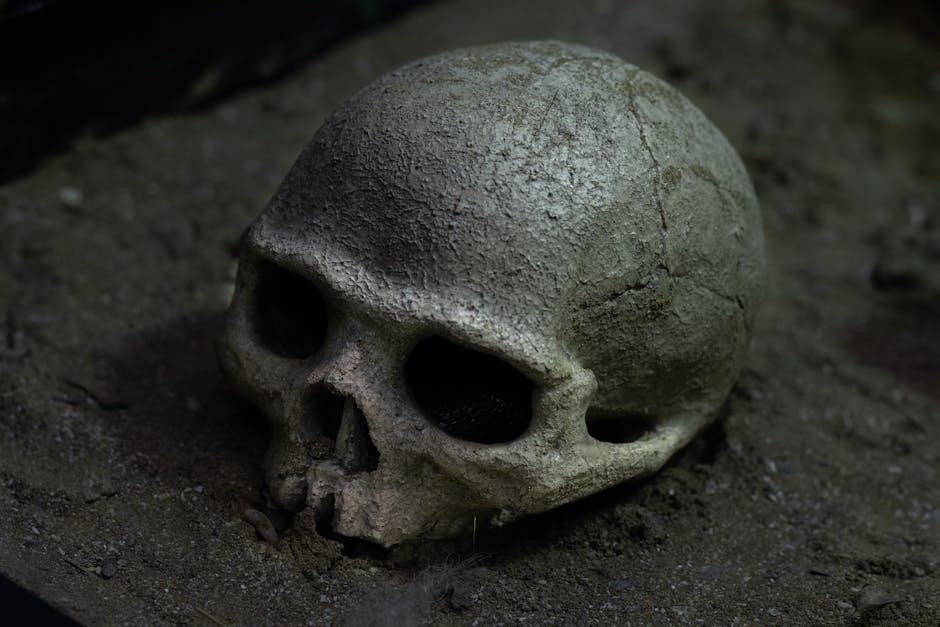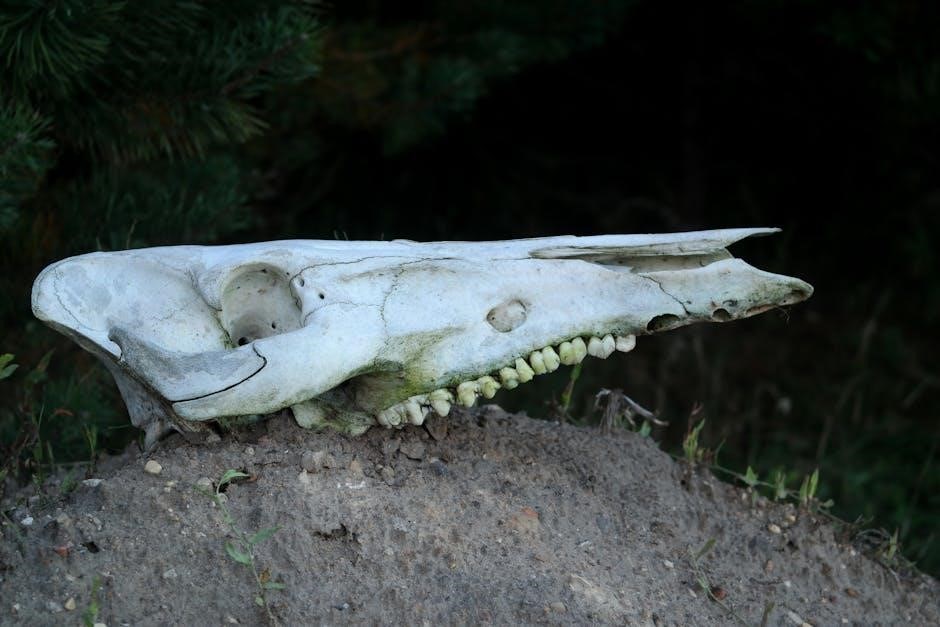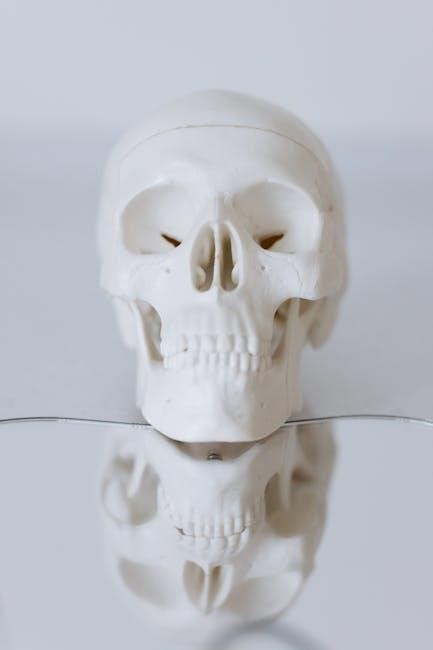The humerus is the longest bone in the upper arm, connecting the shoulder and elbow joints. It plays a crucial role in movement and structural support, with its proximal end forming part of the shoulder joint and its distal end contributing to the elbow. The humerus is connected to numerous muscles, tendons, and ligaments, making it essential for arm mobility and stability. Understanding its anatomy is vital for diagnosing injuries and developing surgical treatments. This section provides a comprehensive overview of the humerus bone, its structure, and its functional significance in the human body.

Overview of the Humerus Bone

The humerus is the longest bone in the upper arm, extending from the shoulder to the elbow. It serves as a vital connector between these two joints, enabling a wide range of movements. The bone is anatomically divided into three main sections: the proximal humerus (near the shoulder), the shaft (the long, cylindrical body), and the distal humerus (near the elbow). Its structure supports muscle attachments, nerve pathways, and joint stability. The humerus plays a critical role in arm mobility, strength, and overall upper limb function. Understanding its anatomy is essential for medical professionals to diagnose and treat injuries effectively. This bone’s unique design balances flexibility and durability, making it a cornerstone of upper arm anatomy.
Importance of Studying Humerus Anatomy
Studying the humerus anatomy is crucial for understanding its role in upper limb function and movement. It provides insights into how the bone interacts with muscles, nerves, and joints, aiding in the diagnosis and treatment of injuries. For medical professionals, detailed knowledge of the humerus is essential for addressing fractures, dislocations, and surgical interventions. Additionally, understanding its structure helps in preventing injuries and improving rehabilitation strategies. The humerus’s complex anatomy, including its tubercles and condyles, makes it a focal point for orthopedic and anatomical research. By studying the humerus, healthcare providers can develop more effective treatments and therapies, ultimately enhancing patient outcomes and quality of life.
Structure of the Humerus Bone
The humerus is the longest bone in the upper arm, connecting the shoulder and elbow joints. It consists of a proximal head, a shaft, and a distal condyle, providing structural support and enabling movement and stability in the arm.
Proximal Humerus
The proximal humerus is the upper portion of the humerus bone, connecting it to the shoulder joint. It includes the humeral head, anatomical neck, and greater and lesser tubercles. The humeral head articulates with the glenoid cavity of the scapula, enabling shoulder movement. The anatomical neck is a slight narrowing below the head, while the tubercles serve as attachment points for muscles like the supraspinatus, infraspinatus, teres minor, and subscapularis. These structures are crucial for shoulder stability and mobility. The proximal humerus is also a common site for fractures, particularly in older adults, often requiring surgical intervention. Understanding its anatomy is essential for diagnosing and treating injuries in this region.
Humerus Shaft
The humerus shaft, or diaphysis, is the long, cylindrical portion of the bone between the proximal and distal ends. It is smooth in texture but features key anatomical landmarks. The deltoid tuberosity, a roughened area on the lateral side, serves as the attachment point for the deltoid muscle, facilitating shoulder movement. The radial groove, located posteriorly, houses the radial nerve, protecting it as it descends along the arm. The shaft also provides attachment points for muscles like the brachialis and triceps brachii. Its strong cortical bone structure supports the arm’s weight and movement. Fractures of the humerus shaft, often occurring in the middle third, can impact nerve function and mobility, requiring precise treatment to restore arm function.
Distal Humerus
The distal humerus is the lower portion of the bone, forming the elbow joint. It features two rounded condyles (medial and lateral) that articulate with the radius and ulna bones of the forearm. The condyles are separated by a groove for the ulnar nerve. Above the condyles are the medial and lateral epicondyles, which serve as attachment points for forearm muscles. The distal humerus also includes the supracondylar process, a bony projection above the condyles. This region is prone to fractures, particularly in children, due to its thin cortical bone. The distal humerus plays a critical role in elbow flexion, extension, and rotation, making it essential for forearm mobility and function. Its complex anatomy requires precise surgical intervention when injured to restore movement and strength.
Proximal Humerus Anatomy
The proximal humerus is the upper portion of the bone, forming part of the shoulder joint. It includes the head, anatomical neck, and greater and lesser tubercles, which are vital for shoulder movement and muscle attachment.
Humerus Head
The humerus head is the uppermost part of the bone, forming a rounded structure that articulates with the glenoid cavity of the scapula to form the shoulder joint. It is covered with a layer of articular cartilage, allowing for smooth movement and reducing friction during arm rotations. The head is connected to the rest of the humerus via the anatomical neck, a narrow region just below the head. This area is a common site for muscle attachments, particularly the rotator cuff muscles, which stabilize the shoulder. The humerus head plays a critical role in enabling a wide range of arm movements, from flexion to abduction, making it essential for daily activities and athletic performance. Injuries to this region can significantly impair shoulder function and mobility.
Anatomical Neck of the Humerus
The anatomical neck of the humerus is a narrow, cylindrical region located just below the humerus head. It serves as the transition zone between the head and the greater and lesser tubercles. This area is significant for muscle attachments, particularly the rotator cuff muscles, which stabilize the shoulder joint. The anatomical neck is also a common site for fractures, especially in older adults, due to its proximity to the joint and its relatively weaker structure. Understanding its anatomy is crucial for diagnosing and treating shoulder injuries. The anatomical neck plays a vital role in shoulder mobility and stability, making it a key focus in orthopedic studies and surgical interventions.
Greater and Lesser Tubercles
The greater and lesser tubercles are prominent bony projections located on the proximal humerus, serving as attachment points for muscles of the rotator cuff. The greater tubercle is situated laterally and is larger, while the lesser tubercle is smaller and located anteriorly. These tubercles provide a broad surface area for muscle insertion, enhancing shoulder mobility and stability. The supraspinatus, infraspinatus, teres minor, and subscapularis muscles attach to these tubercles, enabling movements such as abduction, external rotation, and internal rotation. Injuries or fractures in this region can significantly impair shoulder function, making the tubercles a critical focus in orthopedic and anatomical studies. Their anatomical structure is essential for understanding shoulder mechanics and treating related injuries.
Humerus Shaft Anatomy
The humerus shaft, or diaphysis, is a long, cylindrical structure connecting the proximal and distal ends. It features the deltoid tuberosity and radial groove, providing attachment points for muscles and protection for nerves, essential for arm movement and stability.

Deltoid Tuberosity
The deltoid tuberosity is a roughened, elongated area located on the lateral aspect of the humerus shaft, approximately halfway between the shoulder and elbow. It serves as the primary attachment site for the deltoid muscle, which is responsible for shoulder abduction and arm movement. This prominent bony landmark is essential for muscle anchorage, enabling the deltoid to exert force effectively. The tuberosity’s texture provides a secure grip for the muscle’s tendinous fibers, ensuring proper biomechanical function. Its position along the humerus shaft also contributes to the bone’s overall strength and stability, making it a critical anatomical feature for upper limb mobility and functionality.
Radial Groove
The radial groove, also known as the spiral groove, is a prominent longitudinal depression located on the posterior aspect of the humerus shaft. It runs diagonally downward from the greater tubercle to the posterior surface of the bone, near the midpoint of the shaft. This groove serves as a passageway for the radial nerve, which courses through it as it descends toward the forearm. The radial nerve is responsible for innervating the extensor muscles of the forearm and providing sensory innervation to the back of the hand. The radial groove protects the nerve as it travels along the humerus, ensuring proper motor and sensory function in the arm and hand. Damage to this area can lead to nerve-related clinical issues, highlighting its anatomical and functional importance.

Distal Humerus Anatomy
The distal humerus forms the lower end of the bone, connecting to the forearm bones at the elbow joint. It includes the condyles, epicondyles, and supracondylar process, facilitating movement and stability.
Condyles of the Humerus
The condyles of the humerus are bony projections located at the distal end of the bone, forming the elbow joint. They consist of the trochlea and capitellum. The trochlea, a spool-shaped surface, articulates with the ulna, while the capitellum, a rounded surface, connects with the radius. Together, they enable flexion and extension of the elbow. The condyles are supported by the medial and lateral epicondyles, which provide attachment points for muscles and ligaments. These structures are crucial for joint stability and movement. The condyles also play a key role in absorbing and distributing forces during arm movements, making them vital for overall arm function and mobility. Their anatomy is essential for understanding elbow injuries and surgical interventions.
Medial and Lateral Epicondyles
The medial and lateral epicondyles are bony projections located on the distal humerus, serving as attachment points for muscles and ligaments. The medial epicondyle, on the inner side of the elbow, anchors flexor muscles of the forearm, while the lateral epicondyle, on the outer side, anchors extensor muscles. These epicondyles provide stability to the elbow joint and facilitate forearm movement. They are also common sites for injuries, such as epicondylitis, often caused by overuse or repetitive strain. Understanding their anatomy is crucial for diagnosing and treating conditions like golfer’s elbow and tennis elbow. The epicondyles play a vital role in the functional integrity of the elbow and forearm, making them significant in both anatomical and clinical contexts.
Supracondylar Process
The supracondylar process is a bony projection located above the condyles of the distal humerus. It serves as an attachment point for muscles and ligaments, enhancing elbow stability. This process is clinically significant, as it can be involved in fractures or injuries affecting the distal humerus. In some cases, the supracondylar process may be included in surgical flaps for reconstructive procedures, particularly when vascularized bone and soft tissue are needed for composite defects. Its anatomical position makes it a key landmark in humerus anatomy, particularly for understanding the distal region’s structure and function. The supracondylar process also plays a role in muscle attachment, contributing to forearm movement and overall upper limb functionality.
Functions of the Humerus Bone
The humerus, the longest upper arm bone, connects the shoulder and elbow joints, enabling movement and flexibility. It serves as a key muscle attachment point and protects nerves.
Movement and Flexibility

The humerus plays a vital role in enabling movement and flexibility in the upper arm. Its structure allows for a wide range of motions, including flexion, extension, abduction, and rotation. The bone’s proximal end, with the humeral head, facilitates shoulder movements, while the distal end contributes to elbow flexion and extension. The shaft of the humerus provides attachment points for muscles that control these movements, ensuring precise coordination. Additionally, the bone’s surface features, such as the deltoid tuberosity and radial groove, accommodate muscle and nerve pathways, enhancing mobility. This anatomical design allows the humerus to support both everyday activities and complex movements, making it essential for upper limb functionality and overall physical performance.
Muscle Attachment Points

The humerus serves as a critical anchor for numerous muscles, enabling a wide range of upper limb movements. Its surface features, such as the greater and lesser tubercles, provide attachment points for muscles like the supraspinatus, infraspinatus, and subscapularis, which are essential for shoulder mobility. The deltoid tuberosity along the shaft is where the deltoid muscle attaches, facilitating arm abduction and flexion. Additionally, the distal humerus, including the medial and lateral epicondyles, serves as the origin for flexor and extensor muscles of the forearm. These attachments allow for precise control of arm and hand movements, making the humerus a cornerstone of upper limb functionality and dexterity. The bone’s anatomical design ensures efficient muscle leverage, enabling both strength and agility in daily activities and complex motions.
Nerve Protection and Support
The humerus plays a vital role in protecting and supporting nerves essential for upper limb function. The radial groove, located on the posterior aspect of the humerus shaft, serves as a channel for the radial nerve, shielding it from injury. This nerve is crucial for wrist and finger extension, as well as sensory function in the hand. Additionally, the bone’s anatomical structure near the elbow, such as the medial and lateral epicondyles, provides pathways for nerves like the ulnar and median nerves. These nerves are protected as they pass through the cubital tunnel and carpal tunnel, respectively. The humerus’s design ensures that these nerves remain safeguarded while allowing for complex movements of the arm and hand. This anatomical arrangement highlights the bone’s dual role in structural support and neural protection, making it indispensable for maintaining upper limb functionality and sensory integrity.

Clinical Aspects of the Humerus
The humerus is prone to fractures, particularly in the proximal and distal regions, often requiring surgical intervention. Understanding its anatomy aids in diagnosing and treating injuries effectively, ensuring proper recovery and functionality of the upper limb.
Common Fractures and Injuries
The humerus is susceptible to various fractures, particularly in the proximal and distal regions. Proximal humerus fractures often occur due to falls or direct trauma, while distal fractures near the elbow are common in sports injuries. The humeral shaft can fracture from high-impact incidents like car accidents. Symptoms include severe pain, swelling, and limited arm mobility. Proper diagnosis, often through imaging techniques like X-rays or CT scans, is crucial for treatment. Nondisurgical methods, such as immobilization, are used for stable fractures, while surgical interventions like open reduction and internal fixation are necessary for complex cases. Understanding the anatomy of the humerus is essential for effective treatment and recovery, ensuring restored function and mobility in the affected limb;
Surgical Treatments and Repair

Surgical treatments for humerus injuries often involve procedures like open reduction and internal fixation (ORIF) to realign and stabilize fractures. Intramedullary nailing is another method, where a rod is inserted into the bone shaft for support. For complex fractures, especially in the proximal or distal regions, plates and screws may be used to secure bone fragments. In cases of severe damage, such as nonunion or malunion, bone grafts or osteotomy might be necessary. The lateral arm flap, including the distal humeral metaphysis, is sometimes used for reconstructive surgery in composite defects. Understanding the humerus anatomy is critical for precise surgical planning and successful outcomes, ensuring proper healing and restored function in the arm and shoulder joint.

Imaging Techniques for Humerus Anatomy
X-rays and CT scans provide detailed views of the humerus, identifying fractures and bone structure. MRI and ultrasound are used for soft tissue assessment, aiding in injury diagnosis and treatment planning.
X-Ray and CT Scan
X-rays and CT scans are essential imaging techniques for examining the humerus bone. X-rays provide clear images of bone fractures, dislocations, and structural abnormalities, making them ideal for initial assessments. CT scans offer detailed cross-sectional views, enhancing the visualization of complex fractures and bone alignment. These imaging modalities are crucial for diagnosing injuries, planning surgical interventions, and monitoring the healing process. X-rays are non-invasive and cost-effective, while CT scans deliver high-resolution images for precise diagnostics. Together, they play a vital role in understanding humerus anatomy and guiding effective treatment strategies in clinical settings.
MRI and Ultrasound
MRI and ultrasound are advanced imaging techniques used to evaluate the humerus bone and surrounding tissues. MRI provides detailed images of soft tissues, such as muscles, tendons, and ligaments, making it ideal for diagnosing injuries or abnormalities. It is particularly useful for assessing the rotator cuff and other structures around the shoulder. Ultrasound, on the other hand, offers real-time imaging, which is beneficial for guiding injections or assessing dynamic movement. Both modalities are non-invasive and provide valuable insights into the humerus and its associated anatomy. MRI is especially advantageous for complex diagnoses, while ultrasound is often used for quick, cost-effective assessments. Together, they complement X-rays and CT scans in providing a comprehensive understanding of humerus anatomy and pathology.
The humerus bone is a vital structure in the upper arm, essential for movement, stability, and overall musculoskeletal function. Its complex anatomy, including the proximal head, shaft, and distal condyles, supports a wide range of motions and muscle attachments. Understanding the humerus is crucial for diagnosing injuries, such as fractures, and developing effective treatments. Imaging techniques like X-rays, CT scans, MRIs, and ultrasounds provide detailed insights into its structure and any potential abnormalities. This knowledge is invaluable for medical professionals, ensuring accurate diagnoses and successful surgical interventions. In conclusion, the humerus plays a central role in the human body, and its anatomy remains a key area of study in orthopedics and anatomy. Its significance extends to both clinical practice and everyday functional movements, making it a fundamental topic in medical education and research.
